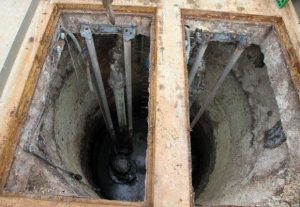
Sewer & Waste Water Infrastructure Corrosion Prevention
The root cause of odours and corrosion in sewer collection systems is sulphide generation by bacteria in waste water passing through sewer pipes and infrastructure. The gas released by this bacteria – hydgrogen sulphide (“rotten egg gas” – H2S) is the primary cause of odours in sewer infrastructure. Another type of aerobic bacteria then utilises the H2S gas in the head space of the sewer infrastructure to produce sulphuric acid (H2So4) which corrodes concrete causing damage wastewater pipes and facilities. In severe situations, sewer pipe and manhole failures and collapses can result in disruption of services and uncontrolled releases of waste water into the environment. Damage such as this can result in repair costs in the millions of dollars.
Rather than allowing the build-up of H2S gas in the sewer infrastructure, an OdaTech force-ventilated odour control system continuously extracts air from the head space, preventing corrosion while also eliminating complaints from nearby residents.

Acid corrosion at Toodyay Waste Water Pump Station #2 – caused by acidic hydrogen suphide gas being trapped in the wet well.

